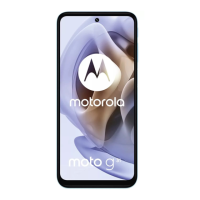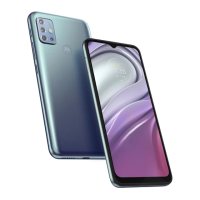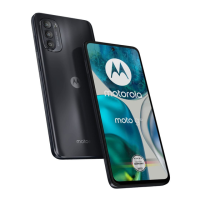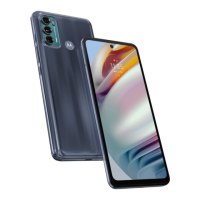Do you have a question about the Motorola moto g7 and is the answer not in the manual?
Details about the phone's physical components and their functions.
Instructions for handling SIM and SD cards, including insertion and removal.
Guides on transferring data from an iPhone or Android phone to the new device.
Explains how to set up and manage dual SIM card functionality on the phone.
Steps for setting up and managing voicemail, including password and greeting.
Instructions for configuring personal and corporate email accounts on the phone.
Covers setting up emergency information and messages for the lock screen.
Tips for personalizing the phone's appearance, sound, and security settings.
Highlights new features and improvements in the Android 10 operating system.
Explains the layout and components of the phone's home screen and navigation.
Details how to use and customize the phone's lock screen for security and information.
Basic concepts and tasks for users new to smartphones or Android.
Information on understanding and controlling mobile data usage for apps and services.
Provides general tips and information about phone features and functions.
Compares Android features to iPhone for users transitioning from iOS.
Explains the benefits and maintenance of a Google account for phone services.
Describes the meaning of various icons displayed in the phone's status bar.
Defines common terms and concepts related to phone usage and technology.
Explains how to use touch gestures like tap, drag, swipe, and pinch for navigation.
Details different navigation methods, including gesture and 3-button navigation.
Guide to accessing and adjusting frequently used settings from the quick settings panel.
Instructions on how to manually turn the phone screen off and on, and automatic screen behavior.
Explains various methods for taking screenshots and accessing the screenshot toolkit.
Provides options for editing screenshots, including cropping, drawing, and saving.
Guides on locating saved screenshots within the phone's gallery.
Instructions for turning the phone's flashlight on and off using quick settings or gestures.
Details how to use voice commands with Google Assistant for various phone functions.
Explains how to use voice commands or widgets to get navigation directions.
Instructions on adding and managing the Time and Weather widget on the home screen.
Introduces Digital Wellbeing features to monitor and limit app usage and screen time.
Guides on setting up and managing parental controls for child usage of the phone.
Explains how to use the onscreen keyboard, including resizing and special characters.
Describes how to use text suggestions and auto-correct features for faster typing.
Instructions for adding and switching between multiple keyboard languages.
Details the process of selecting, cutting, copying, and pasting text from various sources.
Explains how to use voice input to type text on the phone, including punctuation.
Guides on setting up and using autofill for personal information in forms.
Instructions for changing the phone's home and lock screen wallpaper using photos or default images.
How to add, remove, and arrange app shortcuts in the Favorites tray for quick access.
Explains how to add widgets, create app shortcuts, and organize them into folders.
Adjusting app icon size, names, and notification dots on the home screen and app tray.
Controls whether the home screen rotates with device orientation or stays fixed.
Steps to disable the Google news feed from the leftmost home screen.
Information on downloading and switching between different launcher apps for home screen customization.
Setting up and managing screen savers for when the phone is idle or docked.
Basic operations for managing apps, including opening, closing, and switching between them.
How to use split-screen view to run two apps simultaneously on the phone.
Explains how to find and manage notifications appearing on the lock screen and status bar.
Actions available directly from notifications, such as replying or dismissing.
Lists and describes the apps that come pre-installed on the phone.
Guides on downloading apps from the Play Store and managing app updates.
How to view, grant, or deny permissions for apps to access phone features and data.
Instructions for uninstalling downloaded apps or disabling pre-installed ones.
Steps to identify and resolve issues caused by third-party apps using safe mode.
Information on using Play Protect to scan for and remove potentially harmful apps.
Using Google Assistant and the search widget to find information online.
Methods for finding apps, settings, phone numbers, and files on the device.
How to visit, bookmark, and manage websites using the Chrome browser.
Covers sending, receiving, and managing SMS and MMS messages, including group messaging.
Instructions for setting up and managing email accounts, sending, and receiving emails.
Using the calendar to track events, set reminders, and manage schedules.
Features of the Clock app, including setting alarms, timers, and using the stopwatch.
Managing photos and videos, including sharing, uploading, and backing them up.
Managing contacts, making calls, and using voicemail services on the phone.
Detailed guide on making and receiving calls, call waiting, and call handling features.
Steps for listening to and managing voicemail messages through the carrier's system.
Instructions for listening to the radio, managing music files, and using volume buttons.
Steps to turn on Wi-Fi, search for available networks, and connect to them.
How to connect the phone directly to other Wi-Fi Direct compatible devices.
Instructions for turning airplane mode on and off to disable wireless connections.
Managing mobile data, setting warnings/limits, and restricting background data usage.
How to share the phone's internet connection via Wi-Fi hotspot, Bluetooth, or USB tethering.
Pairing and managing Bluetooth devices for wireless connections and audio sharing.
Setting up and using NFC for contactless payments and quick information exchange.
Using NFC and Android Beam to share content wirelessly between devices.
Using Quick Share to securely transfer files and links to nearby devices.
Connecting the phone to a computer via USB to transfer files like music, photos, and videos.
Mirroring the phone screen or casting media content to a TV using Chromecast or compatible apps.
Connecting the phone to a TV to view or play media using Wi-Fi Direct.
Setting default apps for specific actions and managing app permissions by feature or app.
Controlling special app access like usage data, unrestricted data, and picture-in-picture.
Managing app notification settings, silencing apps, and adjusting notification volume.
Controlling notification dots on app icons to indicate unread notifications.
Customizing which notifications appear on the lock screen and hiding sensitive content.
Instructions on how to connect the phone to a charger and check charging status.
Tips and settings to optimize battery usage and extend battery life.
Enabling the display of the battery percentage in the status bar for better monitoring.
Freeing up space on the phone by scanning for unused items or manually clearing data.
Moving apps, photos, and music to an SD card, and ejecting or formatting the card.
Locating and managing files downloaded from the internet or other sources.
Information on trying to recover accidentally deleted photos, videos, or texts.
Storing music files in the cloud for access across devices.
Using the phone's camera to scan documents and save them to Google Drive.
Controlling various audio volumes, including call, media, ringtone, and alarms.
Using Do Not Disturb mode to mute sounds and vibrations for calls and notifications.
Changing default ringtones, setting custom ringtones for contacts, and app notifications.
Finding and installing additional ringtones from the Play Store or computer.
Adjusting sound profiles for headphones or connected devices, and using Moto Audio features.
Setting screen brightness and managing adaptive brightness for optimal viewing.
Changing the screen to a dark background to reduce eye strain and save battery.
Adjusting text size, icon size, and other display elements for comfort and convenience.
Preventing the screen from rotating automatically or allowing rotation based on device orientation.
Automatically changing screen colors to amber or grayscale for better nighttime viewing.
Selecting color modes for a realistic or enhanced look on the screen.
Managing battery-friendly notifications that fade in and out when the screen is off.
Adjusting how long the screen stays on before automatically turning off.
Features for users with visual impairments, including color correction and magnification.
Inverting screen colors to switch between light and dark backgrounds for easier reading.
Enlarging parts of the screen using triple-tap gestures or accessibility shortcuts.
Enabling screen reader functionality to hear descriptions of touch interactions and content.
Adjusting response times and using external switches or keyboards for easier phone control.
Setting up buttons or gestures for quick access to essential accessibility features.
Using NFC for quick and secure information exchange, contactless payments, and sharing.
Using Play Protect to scan for and remove potentially harmful apps.
Setting up Find My Device to remotely locate, lock, or erase the phone if lost or stolen.
Setting up a pattern, PIN, or password to secure the phone and control lock screen content.
Options to keep the phone unlocked based on trusted devices, locations, or on-body detection.
Controlling automatic screen locking time and power button behavior for security.
Keeping the phone unlocked when connected to trusted Bluetooth devices like watches or cars.
Setting up and using face matching to unlock the phone quickly and conveniently.
Keeping the phone unlocked when at familiar and trusted locations like home or work.
Enabling on-body detection to keep the phone unlocked while it's being held or carried.
Setting up and using the fingerprint sensor for unlocking, purchases, and app sign-ins.
Keeping an app in view until unpinned, preventing navigation to other screens.
Setting up a SIM card lock with a PIN to prevent unauthorized use of the cellular plan.
Adjusting app permissions to access specific data and phone features at any time.
Controlling which location information the phone uses and reviewing apps that access location.
Managing Google, email, and app accounts, including adding and removing them.
Understanding and controlling automatic syncing for Google apps and other accounts.
Reviewing, deleting, and controlling the information Google collects about user activity.
Customizing the keyboard, resizing it, changing its appearance, and adjusting sounds.
Changing the display language and adding languages to the keyboard for multilingual use.
Customizing power button gestures, system navigation, and fingerprint gestures.
Managing phone users, guests, and restricting calls/messages for different profiles.
Finding the phone's IMEI number and accessing legal and product information.
Troubleshooting common hardware problems like slow performance, overheating, and screen issues.
Resolving problems related to making/receiving calls, signal strength, and SIM card recognition.
Addressing charging problems, battery drain, and optimizing battery life.
Troubleshooting connectivity problems with Bluetooth, Wi-Fi, and USB connections.
Resolving issues related to forgotten unlock codes, Google account sign-in, and account syncing.
Troubleshooting problems with apps, including crashes, missing icons, and camera errors.
Steps for updating Android software, resetting network settings, and performing factory resets.
| Talk time (3G) | - h |
|---|---|
| Battery capacity | 3000 mAh |
| Battery technology | - |
| Themes | Wallpapers |
| Graphics card | Adreno 506 |
| Personalization | Icons, Menu, Shortcuts |
| Fingerprint reader | Yes |
| Personal info management (PIM) | Alarm clock, Calculator, Calendar, Events reminder, Notes |
| Panel type | LCD |
| Screen shape | Flat |
| Pixel density | 294 ppi |
| Display diagonal | 5.7 \ |
| Touch technology | Multi-touch |
| Touchscreen type | Capacitive |
| Display resolution | 1512 x 720 pixels |
| Native aspect ratio | 19:9 |
| Gorilla Glass version | Gorilla Glass 3 |
| 4G standard | LTE |
| 2G standards | GSM |
| 3G standards | WCDMA |
| SIM card type | NanoSIM |
| Wi-Fi standards | 802.11b, 802.11g, Wi-Fi 4 (802.11n) |
| Bluetooth version | 4.2 |
| SIM card capability | Dual SIM |
| Mobile network generation | 4G |
| Near Field Communication (NFC) | No |
| Flash type | LED |
| Rear camera type | Single camera |
| Maximum frame rate | 30 fps |
| Video recording modes | 480p, 720p, 1080p, 2160p |
| Rear camera pixel size | 1.12 µm |
| Rear camera aperture number | 2 |
| Resolution at capture speed | 720x480@30fps, 1280x720@30fps, 1920x1080@30fps |
| Front camera aperture number | 2.2 |
| Video capture resolution (max) | 1920 x 1080 pixels |
| Rear camera resolution (numeric) | 13 MP |
| Front camera resolution (numeric) | 8 MP |
| RAM capacity | 2 GB |
| Compatible memory cards | MicroSD (TransFlash) |
| Maximum memory card size | 512 GB |
| Internal storage capacity | 32 GB |
| Color name | Deep Indigo |
| Form factor | Bar |
| Product color | Indigo |
| Processor cores | 8 |
| Processor model | 632 |
| Processor family | Qualcomm Snapdragon |
| Processor frequency | 1.8 GHz |
| Subscription type | No subscription |
| Platform | Android |
| Google applications | Google Maps, Google Play, YouTube |
| App distribution platform | Google Play |
| Operating system installed | Android 9.0 |
| USB connector type | USB Type-C |
| Headphone connectivity | 3.5 mm |
| Multimedia Messaging Service (MMS) | Multimedia Messaging Service (MMS) is a standard way to send messages that include multimedia content to and from a mobile phone over a cellular network |
| Harmonized System (HS) code | 85171300 |
| Depth | 7.99 mm |
|---|---|
| Width | 71.5 mm |
| Height | 147.3 mm |
| Weight | 149 g |











